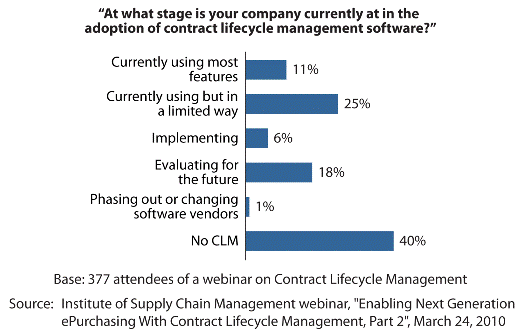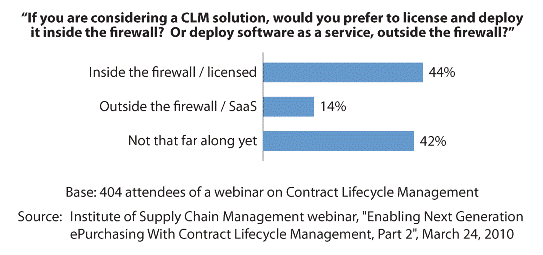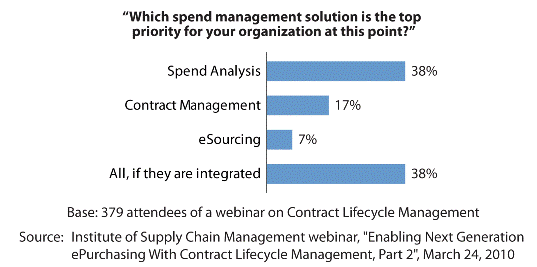Contract Lifecycle Management: “Currently using, but in a limited way”
Last week I had the opportunity to present the first half of a teleconference on contract lifecycle management (CLM) hosted by the Institute of Supply Management (ISM) and Zycus. You should be able to view the recording in its entirety within a week or so here. It was a good session covering the basics of CLM as well as some specific best practices so I recommend taking a look. As part of the presentation we polled the listeners on a few key questions and I'd like to share the results as well as some insights.
First, we asked 'At what stage is your company currently at in the adoption of contract lifecycle management software?' The results: 40% have no CLM software in place today. Almost an equal number of respondents (42%) have a solution.
This is no surprise and matches up to the Forrester market sizing on the ePurchasing space. What was interesting to me was that 25% of audience responded that while they do have a CLM solution in place they are only 'currently using it in a limited way'. To set a little context, before the poll question we talked about what 'limited' means — specifically, only using the solution as a contract repository and not taking advantage of the full lifecycle of functionality.
One of the key takeaways of my presentation was to try and expand the way companies think of CLM to get the most value out of the tool. I recommended taking advantage of expanded analytics to identify contract conflicts and opportunities, contract creation process automation, and integration into ePurchasing and transaction systems to improve controls and compliance.
We also asked listeners to chime in on their preference for a deployment model (i.e. Licensed/inside the firewall versus SaaS outside the firewall). The majority, 44%, voted for licensing the product and keeping it inside the firewall. A smaller number, 14%, preferred software as a service (SaaS). This also syncs with what we know — that end-users prefer a licensed model over SaaS for CLM.
However, we do see SaaS adoption growing faster than licenses in this space. As the vendor solutions mature we are advising that software buyers take another look at the SaaS deployment model for CLM. Common reservations include security and added integration complexity but the solutions have come a long way to alleviate these concerns. If your company is still wary we suggest you look for a SAS70 audit and ask the vendors to see the actual report that goes along with it. At the back of that report you can see a list of any issues that were raised and get a sense for overall risk.
We also asked what solution is a top priority today. In order of preference, the results were Spend Analysis, CLM, and eSourcing. That makes sense given that this is the order we often see companies adopting ePurchasing products. Spend analysis can be an excellent way to get your arms around what you are spending as a baseline to set a sourcing strategy. CLM implementations are sometimes run in parallel or directly follow a spend project.
All in all it was an enjoyable webinar and it's always great to get some audience participation. Look for more research on CLM this year and an updated Forrester Wave evaluation of the software products in Q4.